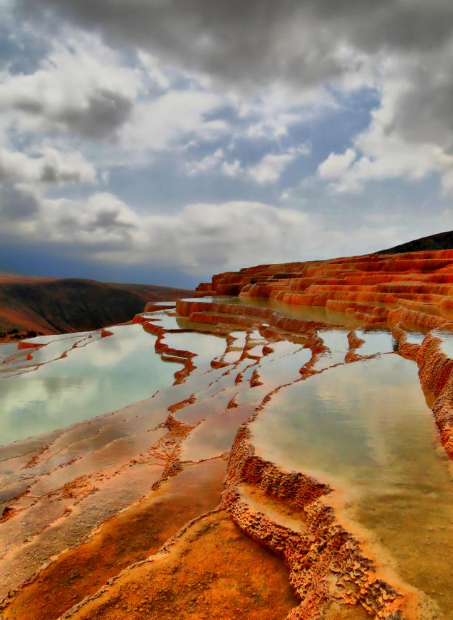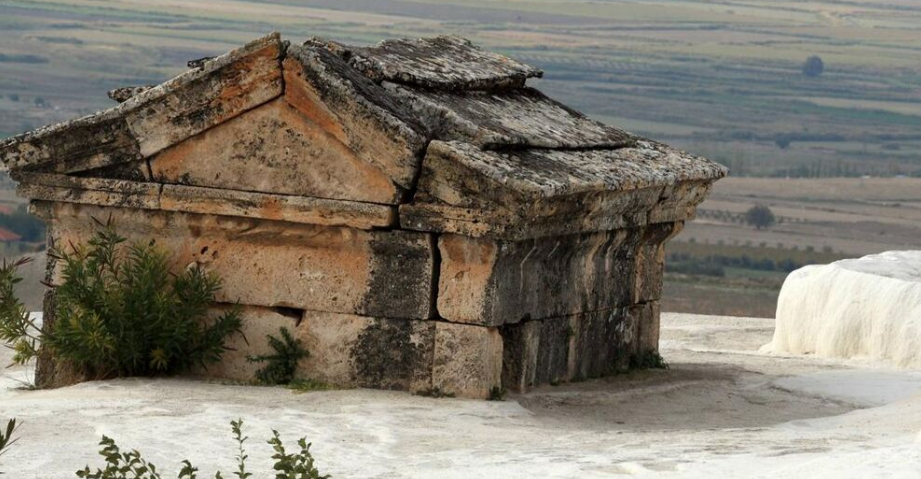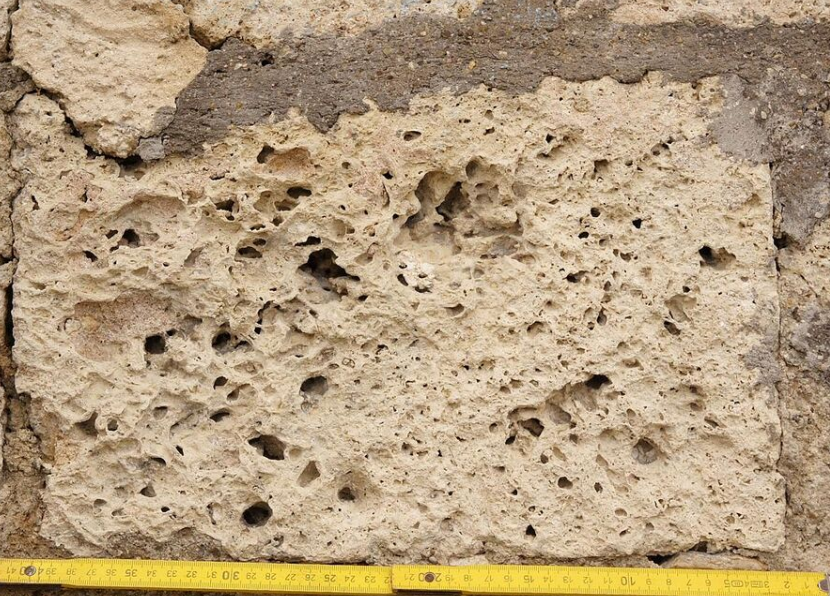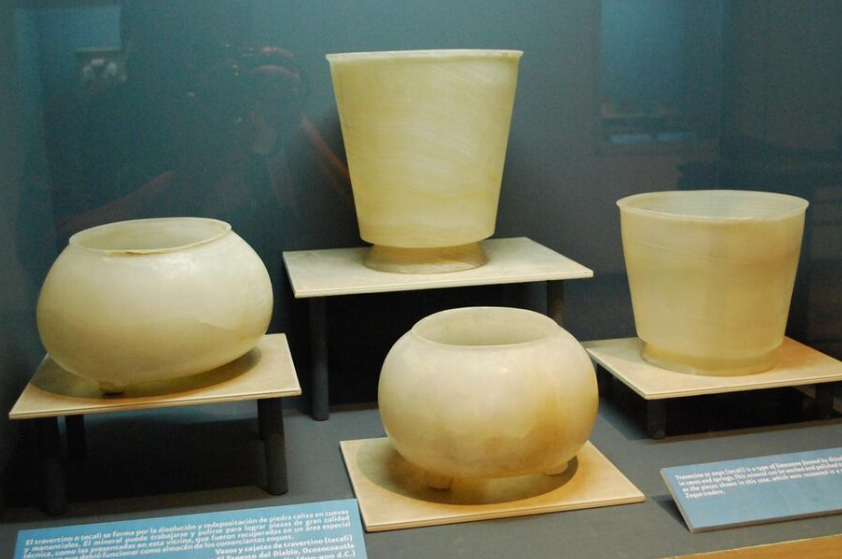
Video Upload Options
Travertine (/ˈtrævərˌtiːn/ TRA-vər-teen) is a form of limestone deposited by mineral springs, especially hot springs. Travertine often has a fibrous or concentric appearance and exists in white, tan, cream-colored, and even rusty varieties. It is formed by a process of rapid precipitation of calcium carbonate, often at the mouth of a hot spring or in a limestone cave. In the latter, it can form stalactites, stalagmites, and other speleothems. It is frequently used in Italy and elsewhere as a building material. Travertine is a terrestrial sedimentary rock, formed by the precipitation of carbonate minerals from solution in ground and surface waters, or geothermally heated hot-springs. Similar (but softer and extremely porous) deposits formed from ambient-temperature water are known as tufa.
1. Etymology
The word 'travertine' is derived from the Italian travertino, itself a derivation of the Latin tiburtinus 'of Tibur'. Its namesake is also the origin of Tivoli, a district near Rome.[1]
2. Geochemistry
Modern travertine is formed from geothermally heated supersaturated alkaline waters, with raised pCO2 (see partial pressure). On emergence, waters degas CO2 due to the lower atmospheric pCO2, resulting in an increase in pH. Since carbonate solubility decreases with increased pH,[2] precipitation is induced. Precipitation may be enhanced by factors leading to a reduction in pCO2, for example increased air-water interactions at waterfalls may be important,[3] as may photosynthesis.[4] Precipitation may also be enhanced by evaporation in some springs.
Both calcite and aragonite are found in hot spring travertines; aragonite is preferentially precipitated when temperatures are hot, while calcite dominates when temperatures are cooler.[5][6] When pure and fine, travertine is white, but often it is brown to yellow due to impurities.
Travertine may precipitate out directly onto rock and other inert materials as in Pamukkale or Mammoth Hot Springs for example.
3. Occurrence


In Italy, well-known travertine quarries exist in Tivoli and Guidonia Montecelio, where the most important quarries since Ancient Roman times can be found.[7] The Guidonia quarry has major historic value, as it was one of the quarries where Gian Lorenzo Bernini selected material from which to build the famous Colonnade of St. Peter's Square in Rome (colonnato di Piazza S. Pietro) in 1656–1667. Michelangelo also chose travertine as the material for the external ribs of the dome of St Peter's Basilica.[8] Travertine derives its name from the former town, known as Tibur in ancient Roman times. The ancient name for the stone was lapis tiburtinus, meaning tibur stone, which was gradually corrupted to travertino (travertine). Detailed studies of the Tivoli and Guidonia travertine deposits revealed diurnal and annual rhythmic banding and laminae, which have potential use in geochronology.[9]
Cascades of natural lakes formed behind travertine dams can be seen in Pamukkale, Turkey, which is a UNESCO World Heritage Site. Other places with such cascades include Huanglong in Sichuan Province of China (another UNESCO World Heritage Site), the Mammoth Hot Springs in the US, Egerszalók in Hungary, Mahallat, Abbass Abad, Atash Kooh, and Badab-e Surt in Iran, Band-i-Amir in Afghanistan, Lagunas de Ruidera, Spain, Hierve el Agua, Oaxaca, Mexico and Semuc Champey, Guatemala.
In Central Europe's last post-glacial palaeoclimatic optimum (Atlantic Period, 8000–5000 BC), huge deposits of tufa formed from karst springs. Important geotopes are found at the Swabian Alb, mainly in valleys at the foremost northwest ridge of the cuesta; in many valleys of the eroded periphery of the karstic Franconian Jura; at the northern Alpine foothills; and the northern Karst Alps. On a smaller scale, these karst processes are still working. Travertine has been an important building material since the Middle Ages.
Travertine has formed sixteen huge, natural dams in a valley in Croatia known as Plitvice Lakes National Park. Clinging to moss and rocks in the water, the travertine has built up over several millennia to form waterfalls up to 70 m (230 ft) in height.[10]
In the U.S., the most well-known place for travertine formation is Yellowstone National Park, where the geothermal areas are rich in travertine deposits.[11] Wyoming also has travertines in Hot Springs State Park in Thermopolis.[12] Oklahoma has two parks dedicated to this natural wonder. Turner Falls, the tallest waterfall in Oklahoma, is a 77 feet (23 m) cascade of spring water flowing over a travertine cave. Honey Creek feeds this waterfall and creates miles of travertine shelves both up and downstream. Many small waterfalls upstream in the dense woods repeat the travertine-formation effect. The city of Davis now owns thousands of acres of this land and has made it a tourist attraction. Another travertine resource is in Sulphur, Oklahoma, 10 miles (16 km) east of Turner Falls. Travertine Creek flows through a spring-water nature preserve within the boundaries of the Chickasaw National Recreation Area.
In Texas , the city of Austin and its surrounding "Hill Country" to the south is built on limestone. The area has many travertine formations, such as those found at Gorman Falls within Colorado Bend State Park, the nature preserve known as Hamilton Pool, the West Cave Preserve, and Krause Springs in Spicewood.
Hanging Lake in Glenwood Canyon in Colorado has travertine deposits and aqua blue water. Rifle Falls State Park in Colorado features a triple waterfall over a travertine dam.[13]
In Arizona, on the south side of the Grand Canyon there is the Havasupai Reservation. Flowing through it is Havasu Creek, which has extensive travertine deposits.[14][15] Three major waterfalls, Navajo Falls, Havasu Falls, and Mooney Falls, are all located downstream from the town of Supai. There are numerous smaller cataracts formed by travertine dams. These features are located about 2 miles (3.2 km) from Supai Village (on the floor of the canyon), and are accessible by foot or horseback.
In Iceland, the Hvanná river, located at the north flank of the Eyjafjallajökull, was heavily charged with CO2 following the 2010 eruptions. Travertine precipitated along the river.[16] By 2014, CO2 concentration in the river has decreased and travertine has started to dissolve. However, in places, where the river changed its bed, travertine covered rocks can still be seen.
In North East Sulawesi, Indonesia is the Wawolesea Karst. A notable feature of this area is a pond several meters from the beach, formed by a salty, hot water fountain extant since the Neogene period.[17]
4. Uses
Travertine is often used as a building material. The Romans mined deposits of travertine for building temples, aqueducts, monuments, bath complexes, and amphitheaters such as the Colosseum,[18] the largest building in the world constructed mostly of travertine. The Shroud of Turin, when examined by Joseph Kohlbeck from the Hercules Aerospace Company in Utah and Richard Levi-Setti of the Enrico Fermi Institute, was found to contain particles of travertine aragonite limestone.
Travertine regained popularity as a building material in the Middle Ages. The central German town of Bad Langensalza has an extant medieval old town built almost entirely of local travertine. 20th Century buildings using travertine extensively include the Sacré-Cœur Basilica in Paris, the Getty Center in Los Angeles , California, and Shell-Haus in Berlin. The travertine used in the Getty Center and Shell-Haus constructions was imported from Tivoli and Guidonia.[19]
Travertine is one of several natural stones that are used for paving patios and garden paths. It is sometimes known as travertine limestone or travertine marble; these are the same stone, although travertine is classified properly as a type of limestone, not marble. The stone is characterised by pitted holes and troughs in its surface. Although these troughs occur naturally, they suggest signs of considerable wear and tear over time. It can also be polished to a smooth, shiny finish, and comes in a variety of colors from grey to coral-red. Travertine is most commonly available in tile sizes for floor installations.
Travertine is one of the most frequently used stones in modern architecture. It is commonly used for façades, wall cladding, and flooring. The lobby walls of the modernist Willis Tower (1970) (formerly Sears Tower) in Chicago are made of travertine.[20] Architect Welton Becket frequently incorporated travertine into many of his projects. The first floor of the Becket-designed UCLA Medical Center has thick travertine walls. Architect Ludwig Mies van der Rohe used travertine in several of his major works, including the Toronto-Dominion Centre, S.R. Crown Hall, the Farnsworth House and the Barcelona Pavilion.
-

Burghausen Castle, Europe's longest castle, is 1,000 years old and built mainly with travertine.
-

Travertine in a 400-year-old wall

-
Travertine vessels found in El Tapesco del Diablo Cave in Ocozocoautla, Chiapas, Mexico (600–900 CE)
5. Supply
Until the 1980s, Italy had a near-monopoly on the world travertine market; now significant supplies are quarried in mainly Turkey, Iran, Mexico, and Peru. Two or three small travertine producers operate in the western United States. US demand for travertine is about 850,000 tons per year, almost all of it imported.
References
- Collins English Dictionary (updated 3rd ed.). Glasgow: HarperCollins. 1994. ISBN 9780004706788. http://www.dictionary.com/browse/travertine. Retrieved 17 January 2017.
- Bialkowski, S.E. 2004. Use of Acid Distributions in Solubility Problems. "Archived copy". Archived from the original on 2009-02-28. https://web.archive.org/web/20090228004440/http://www.chem.usu.edu/~sbialkow/Classes/3600/alpha/alpha3.html. Retrieved 2009-08-04.
- Zhang, D., Y. Zhang, A. Zhu and X. Cheng, 2001, Physical mechanisms of river waterfall tufa (travertine) formation, Journal of Sedimentary Research, 71, pp. 205–216
- Riding, R., 2000, Microbial carbonates: the geological record of calcified bacterial-algal mats and biofilms, Sedimentology, 47, pp. 179–214
- Pentecost, A., 2005, Travertine, Dordrecht, Netherlands: Kluwer Academic Publishers Group. ISBN:1-4020-3523-3
- Fouke, B. W., et al., 2000, Depositional facies and aqueous-solid geochemistry of travertine-depositing hot springs (Angel Terrace, Mammoth Hot Springs, Yellowstone National Park, U.S.A.), Journal of Sedimentary Research, 70, pp. 565–585.
- "quarry Bernini in Guidonia". Archived from the original on February 8, 2011. https://web.archive.org/web/20110208000618/http://www.cimep.it/cms/en/company/bernini-quarry.html.
- Stone, Irving. The Agony and the Ecstasy, 1961.
- Folk, R. L., et al.; (1985) Bizarre forms of depositional and diagenetic calcite in hot spring travertines, in Carbonate Cements: SEPM Special Pub. 36
- "Land Of The Falling Lakes" , Nature, PBS https://www.pbs.org/wnet/nature/fallinglakes/water.html
- Weed, Walter (1890). The formation of travertine and siliceous sinter by the vegetation of hot springs. U.S. Government Printing Office. p. 628. https://archive.org/details/formationoftrave00weedrich.
- "Some flows at hot springs state park are decreasing". Archived from the original on 2017-12-01. https://web.archive.org/web/20171201035719/http://billingsgazette.com/news/state-and-regional/wyoming/some-say-flows-at-hot-springs-state-park-are-decreasing/article_7f58c671-7f06-54f3-8695-0add34c51ee6.html. Retrieved 2017-11-20.
- "Rifle Falls State Park". Archived from the original on 2015-07-12. https://web.archive.org/web/20150712020332/http://cpw.state.co.us/placestogo/parks/RifleFalls/Pages/default.aspx. Retrieved 2015-07-10.
- Crossey, Laura J.; Fischer, Tobias P.; Patchett, P. Jonathan; Karlstrom, Karl E.; Hilton, David R.; Newell, Dennis L.; Huntoon, Peter; Reynolds, Amanda C. et al. (2006). "Dissected hydrologic system at the Grand Canyon: Interaction between deeply derived fluids and plateau aquifer waters in modern springs and travertine". Geology 34 (1): 25. doi:10.1130/g22057.1. ISSN 0091-7613. Bibcode: 2006Geo....34...25C. https://semanticscholar.org/paper/8d3267f9e19368f1a93f6c99510b5564165871f1.
- Melis, Theodore S. (1996). When the blue-green waters turn red : historical flooding in Havasu Creek, Arizona. U.S. Dept. of the Interior, U.S. Geological Survey. OCLC 35199762. http://www.worldcat.org/oclc/35199762
- Olsson, J., et al.; (2014) in Chem. Geol. 384, p. 135
- "Wawolesea". January 29, 2012. Archived from the original on January 30, 2012. https://web.archive.org/web/20120130140516/http://koran-jakarta.com/index.php/detail/view01/82093.
- "The History Of The Tile". Archived from the original on February 28, 2014. https://web.archive.org/web/20140228162643/http://www.youtube.com/watch?v=3HSiERzoEvY.
- "The Getty Center" , Official Website http://www.getty.edu/visit/see_do/architecture.html
- "The Willis Tower" , Official Website http://www.willistower.com/interior_exterior.html




